-
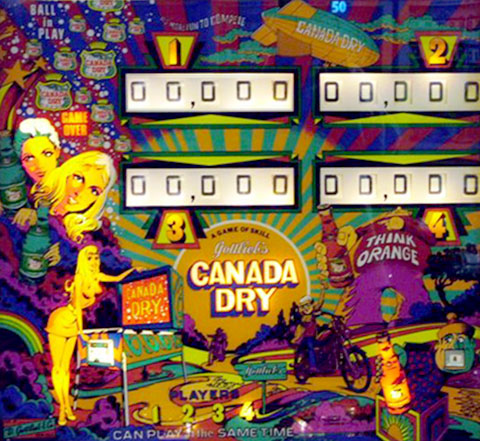 Another rare machine stands before you. Although 2,885 units were produced, they were all sent to France as a promotion in a contest to market Canada Dry soda. Designed by Ed Krynski and art by Gordon Morrison, this game was released in the US as a one player, two player and four player version. If you like drop targets this is your game. Fifteen drop targets live in this playfield design! If you’re skillful enough to hit all the upper drop targets, the side extra ball rollovers activate. The same is true if you hit the bottom five drop targets. If, however, you’re skillful enough to complete all fifteen targets, the specials are activated. Score is another way to win. The machines put on location in France provided high-scoring winners with monetary prizes from Canada Dry. I wish they would do this in the united States, especially in Atlantic City.
Another rare machine stands before you. Although 2,885 units were produced, they were all sent to France as a promotion in a contest to market Canada Dry soda. Designed by Ed Krynski and art by Gordon Morrison, this game was released in the US as a one player, two player and four player version. If you like drop targets this is your game. Fifteen drop targets live in this playfield design! If you’re skillful enough to hit all the upper drop targets, the side extra ball rollovers activate. The same is true if you hit the bottom five drop targets. If, however, you’re skillful enough to complete all fifteen targets, the specials are activated. Score is another way to win. The machines put on location in France provided high-scoring winners with monetary prizes from Canada Dry. I wish they would do this in the united States, especially in Atlantic City. -
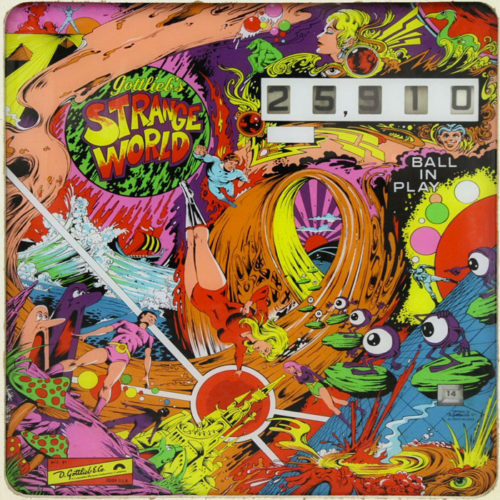
-
 Gottlieb produced a few baseball-themed games, but Williams Manufacturing was the king of these types of games. This game, designed by Ed Krynski with art by Gordon Morison, had a run of 775 units. This is the add-a-ball version of this game, so it is rarer. The replay version is called Grand Slam. This game has eject holes which activate the roto-target, a Gottlieb exclusive device, which stops and a man is lit on a corresponding base to the eject hole on the baseball diamond. The rollover button lights when the bases are loaded. This scores 1,000 points whenever the bases are loaded. Runs and score are the ways to win free balls with this game.
Gottlieb produced a few baseball-themed games, but Williams Manufacturing was the king of these types of games. This game, designed by Ed Krynski with art by Gordon Morison, had a run of 775 units. This is the add-a-ball version of this game, so it is rarer. The replay version is called Grand Slam. This game has eject holes which activate the roto-target, a Gottlieb exclusive device, which stops and a man is lit on a corresponding base to the eject hole on the baseball diamond. The rollover button lights when the bases are loaded. This scores 1,000 points whenever the bases are loaded. Runs and score are the ways to win free balls with this game. -

-
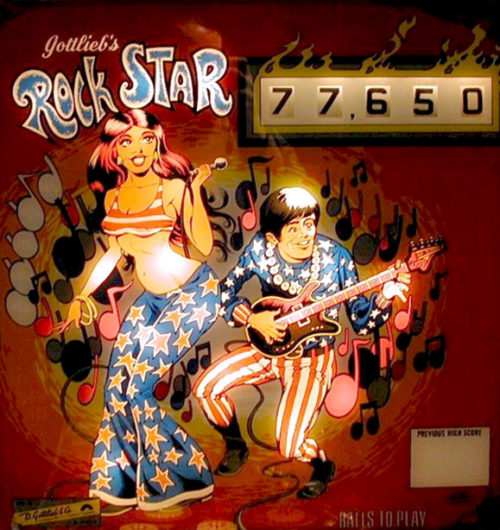 The game before you is extremely rare with only 278 screwed together at the Chicago Gottlieb factory. This one-player electromechanical add-a-ball game was designed by John Osbourne with art by Gordon Morison. A replay version was also designed by the name of Blue Note. The object of this machine is to complete all the notes down the left side of the playfield. Doing so activates the classic “wow” feature which, when hit, awards one free ball. A reset is in your future once your current ball drains. Score is another way to achieve longer play by winning extra balls. The spinner in the middle of the playfield awards big points when 1,000 points is lit; each spin of the target awards 1,000 points plus number of revolutions spun. A nice retro art package completes this rare machine.
The game before you is extremely rare with only 278 screwed together at the Chicago Gottlieb factory. This one-player electromechanical add-a-ball game was designed by John Osbourne with art by Gordon Morison. A replay version was also designed by the name of Blue Note. The object of this machine is to complete all the notes down the left side of the playfield. Doing so activates the classic “wow” feature which, when hit, awards one free ball. A reset is in your future once your current ball drains. Score is another way to achieve longer play by winning extra balls. The spinner in the middle of the playfield awards big points when 1,000 points is lit; each spin of the target awards 1,000 points plus number of revolutions spun. A nice retro art package completes this rare machine. -
 October was the birthdate for this machine. It was designed by Ed Krynski with artwork by Art Stenholm. Low production run of 550 units. This is an add-a-ball game, the replay version being called Sing Along. This game was a variation on a classic Gottlieb game Kings and Queens, in that it contains the four side-by-side kickout holes made popular in 1965. Here, the object of the game is to complete four same-colored numbers vertically in a row to randomly cause the kickout hole to light to score an extra ball if you land in the hole when it’s lit. If you didn’t win a ball, each light in the column would award 10 points. If you have most of the lights lit, a run at the kickout holes awards a lot of points in a hurry which, in this game, also awards extra balls. One center target is also incorporated into the game, awarding 100 points when hit and lights the pop bumpers for higher scoring.
October was the birthdate for this machine. It was designed by Ed Krynski with artwork by Art Stenholm. Low production run of 550 units. This is an add-a-ball game, the replay version being called Sing Along. This game was a variation on a classic Gottlieb game Kings and Queens, in that it contains the four side-by-side kickout holes made popular in 1965. Here, the object of the game is to complete four same-colored numbers vertically in a row to randomly cause the kickout hole to light to score an extra ball if you land in the hole when it’s lit. If you didn’t win a ball, each light in the column would award 10 points. If you have most of the lights lit, a run at the kickout holes awards a lot of points in a hurry which, in this game, also awards extra balls. One center target is also incorporated into the game, awarding 100 points when hit and lights the pop bumpers for higher scoring. -
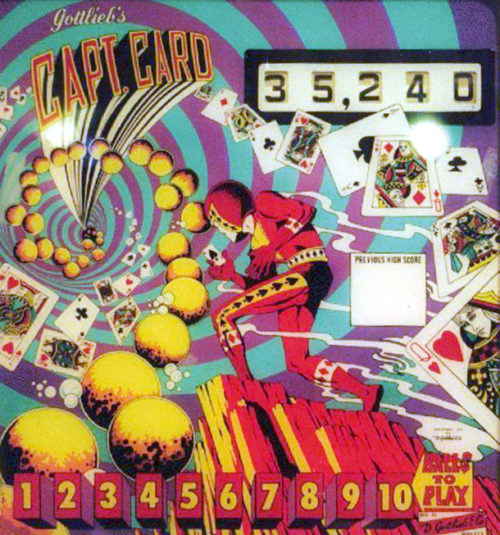 May was the release month for this game. Designer Ed Krynski and artist Gordon Morison put together the package. Production run was low, at 675 units. This is an add-a-ball game variant, the replay version was called High Hand. The challenging part of this playfield design is trying to lock a ball in the eject hole for extra balls. Four batteries of drop targets in four colors are along the sides of the playfield. Making a completion of a color of drop targets increases the value of the eject and side drains. If all the drop targets are completed, the extra ball features light up. Score is another way to win balls set by the operator. No match units were incorporated into these games as, again, that was considered a form of gambling, i.e. winning a free game.
May was the release month for this game. Designer Ed Krynski and artist Gordon Morison put together the package. Production run was low, at 675 units. This is an add-a-ball game variant, the replay version was called High Hand. The challenging part of this playfield design is trying to lock a ball in the eject hole for extra balls. Four batteries of drop targets in four colors are along the sides of the playfield. Making a completion of a color of drop targets increases the value of the eject and side drains. If all the drop targets are completed, the extra ball features light up. Score is another way to win balls set by the operator. No match units were incorporated into these games as, again, that was considered a form of gambling, i.e. winning a free game. -

-
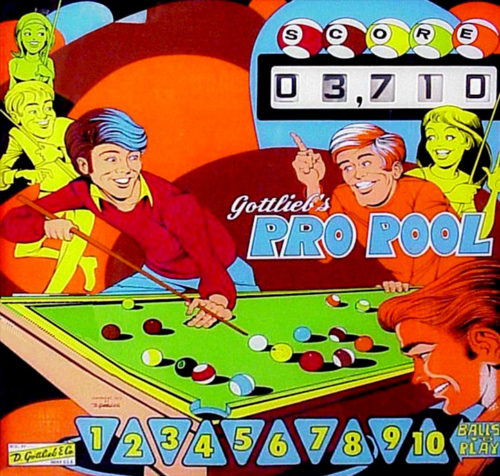 Pro Pool originated in December with 800 units being fabricated. This add-a-ball machine was designed by Ed Krynski with artwork by Gordon Morison. Two replay versions of the game were also made: a two-player version called Big Shot and a four-player version called Hot Shot. Obviously the theme of this game is the game of pool. The playfield is symmetrical and the way to win extra balls is by completing the left and/or right drop target battery. Doing so will lift the left and/or right wow rollovers for this award. The drop targets reset once the sequences are completed. Of course, an operator-adjusted score is another way to score a couple of balls. Back in the ‘70s, multiple balls or replays could be achieved on the game. Today, one free game on a current solid-state game is the common win. Operators have made it harder to achieve free games today as free games yield no income and only result in down time for the machine to earn coins in the till.
Pro Pool originated in December with 800 units being fabricated. This add-a-ball machine was designed by Ed Krynski with artwork by Gordon Morison. Two replay versions of the game were also made: a two-player version called Big Shot and a four-player version called Hot Shot. Obviously the theme of this game is the game of pool. The playfield is symmetrical and the way to win extra balls is by completing the left and/or right drop target battery. Doing so will lift the left and/or right wow rollovers for this award. The drop targets reset once the sequences are completed. Of course, an operator-adjusted score is another way to score a couple of balls. Back in the ‘70s, multiple balls or replays could be achieved on the game. Today, one free game on a current solid-state game is the common win. Operators have made it harder to achieve free games today as free games yield no income and only result in down time for the machine to earn coins in the till. -
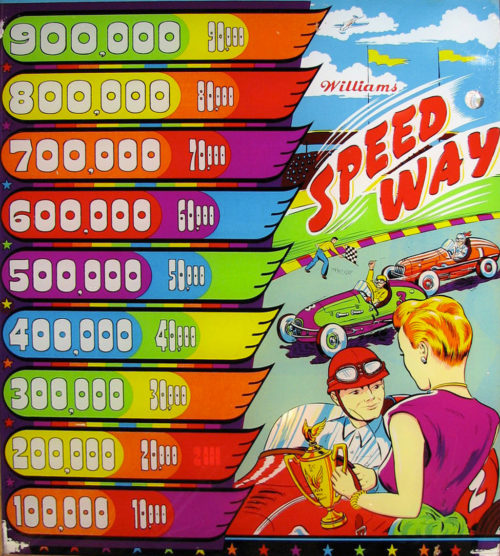
-
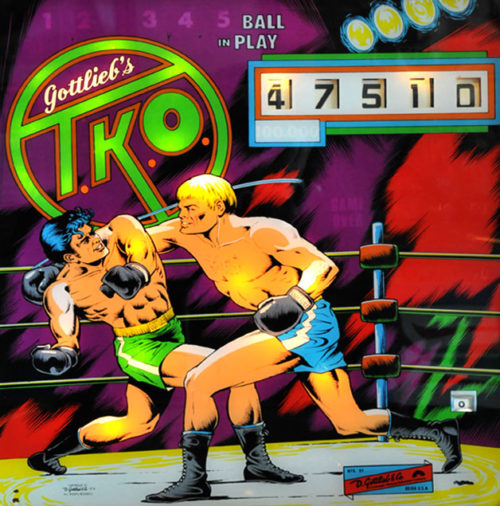 Look no further! If you’re searching for the rarest of the rare, here for your perusal is not one but two examples of this Gottlieb aberration. Supposedly only 125 were made of this game and most were sold overseas. Ed Krynski and Gordon Morison again teamed up to art and design the game. This game represents one of the last electromechanical “wedgehead” games ever built near the shores of Lake Michigan. It’s also a single-player game and one of the last. The object of the game is not really boxing in the true sense but hitting enough targets to advance the central advance display up to the top of the rack. This will ignite the special lights for a free game. The color-coordinated advance inserts on the play field correspond to the light-up features on the play field and, if you advance the light sequence accordingly, those features light up for the brief time the advance mechanism stays on that light. Score is the easiest way to win a replay.
Look no further! If you’re searching for the rarest of the rare, here for your perusal is not one but two examples of this Gottlieb aberration. Supposedly only 125 were made of this game and most were sold overseas. Ed Krynski and Gordon Morison again teamed up to art and design the game. This game represents one of the last electromechanical “wedgehead” games ever built near the shores of Lake Michigan. It’s also a single-player game and one of the last. The object of the game is not really boxing in the true sense but hitting enough targets to advance the central advance display up to the top of the rack. This will ignite the special lights for a free game. The color-coordinated advance inserts on the play field correspond to the light-up features on the play field and, if you advance the light sequence accordingly, those features light up for the brief time the advance mechanism stays on that light. Score is the easiest way to win a replay. -
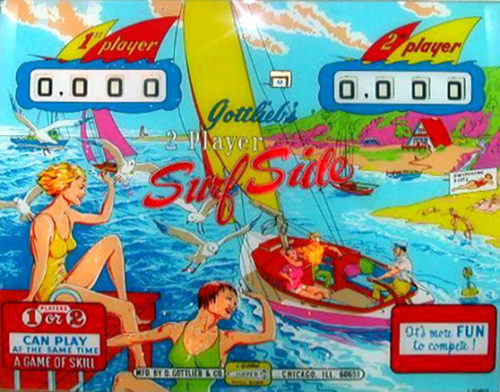 This pinball had a run of 1750 units. Designed by Ed Krynski with artwork by Art Stenholm, this 2 player four flipper game has no specials. The object of the game is to score a lot of points by advancing the yellow and red multipliers up to 100x where up to 500 points could be hit. Hitting the 100x level resets the hit column back to 1x. Extra balls are awarded if the roto spin target is hit when the star is in position. The use of the four flippers in the game makes one feels that the machine has two playfields in one. The new design pop bumpers, and auto ball lift are in early use here as well as the ball count meter. A challenging game that’s hard to beat!!!
This pinball had a run of 1750 units. Designed by Ed Krynski with artwork by Art Stenholm, this 2 player four flipper game has no specials. The object of the game is to score a lot of points by advancing the yellow and red multipliers up to 100x where up to 500 points could be hit. Hitting the 100x level resets the hit column back to 1x. Extra balls are awarded if the roto spin target is hit when the star is in position. The use of the four flippers in the game makes one feels that the machine has two playfields in one. The new design pop bumpers, and auto ball lift are in early use here as well as the ball count meter. A challenging game that’s hard to beat!!!